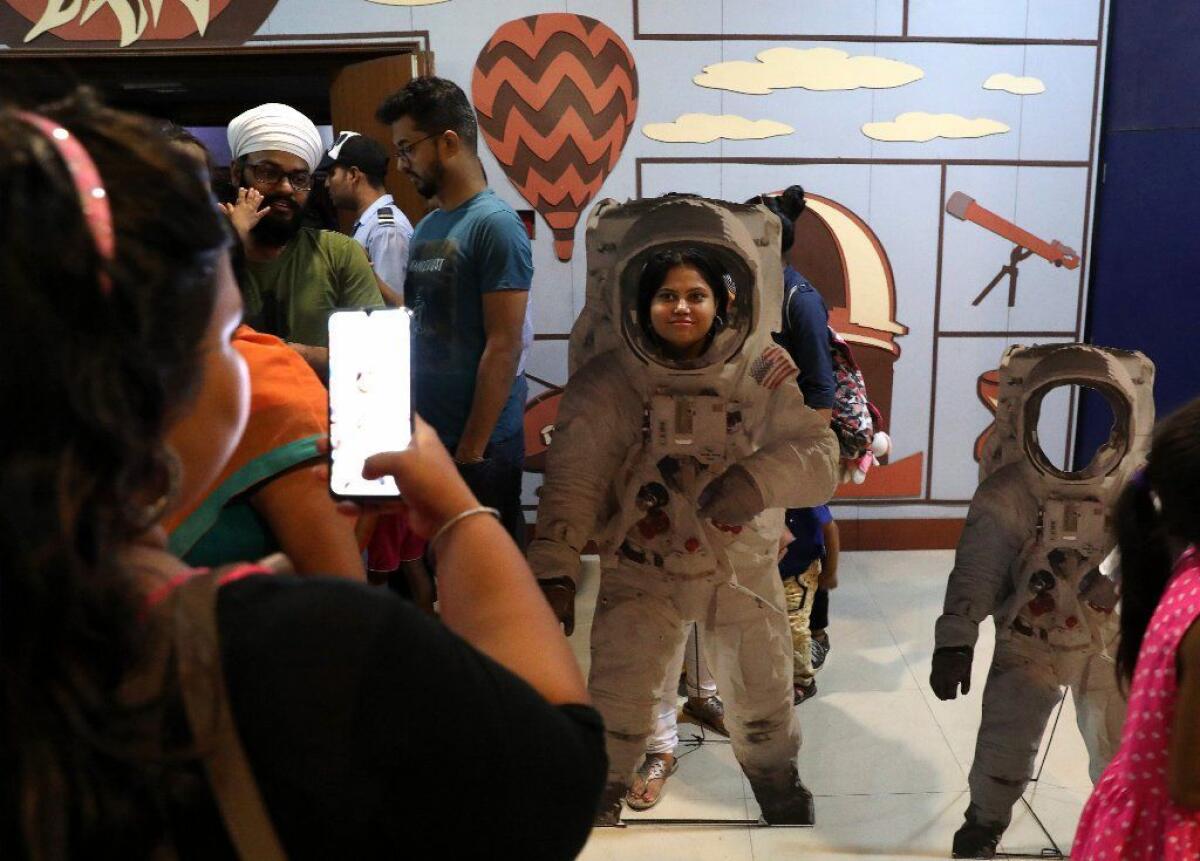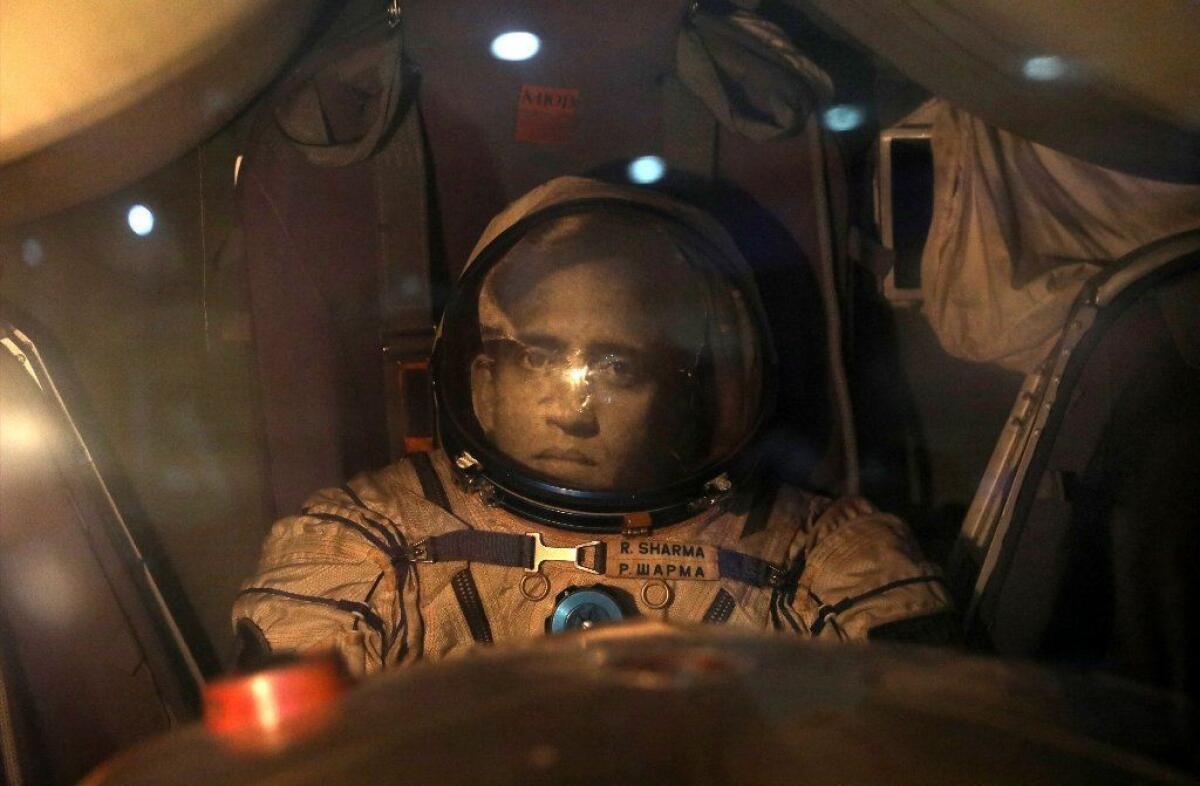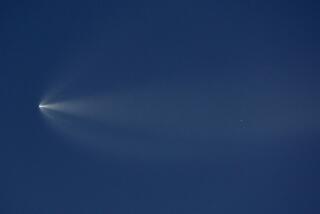India scrubs historic moon mission less than an hour before liftoff
Just 54 minutes before launch, India postponed a historic unmanned mission to the south pole of the moon on Monday due to a “technical snag.”
The Indian Space Research Organization, or ISRO, said a problem was detected in the launch vehicle system of Chandrayaan-2, the country’s first attempt to safely land a rover on the moon.
The agency said that the decision to scrub the launch, which had been scheduled for 2:51 a.m., was taken “as a measure of abundant precaution” and that a revised date would be announced later.
The postponement marked a temporary setback for India’s efforts to join a growing global space race.
Built entirely with homegrown expertise and technology, and for the relatively low price of about $140 million, the lunar mission has been designed to gather detailed information about water frozen inside large, shadowy craters pocking the unexplored lunar south pole, discoveries that could be crucial to realizing the vision of humans living on the moon.
Nearly 50 years after NASA’s historic Apollo 11 moon landing, a crop of extraterrestrial missions are being planned by the U.S., Chinese and other national space agencies, along with private initiatives financed by tech billionaires. India had been aiming to become just the fourth country after the United States, Russia and China to safely land a probe on the moon’s surface.
“Globally this is a pioneering mission for human habitation beyond Earth,” Chaitanya Giri, a fellow of the space and ocean studies program at Gateway House, an Indian think tank, said before the launch was scrubbed.
Carrying more than a dozen scientific payloads, including a NASA tool designed to gather precise measurements of the distance to the Earth, the spacecraft was due to land near the lunar south pole around Sept. 6, according to ISRO.
Scientists said the lander would deploy a 60-pound, six-wheeled rover to roll slowly across the lunar surface for about two weeks collecting information before its solar battery runs out. An orbiter is expected to circle the moon for about a year, relaying information and capturing high-resolution images.
Besides measuring quantities of water — which could help in the manufacture of potable water and rocket fuel to sustain future manned missions — the Indian mission is also expected to gather data on deposits of materials such as helium-3, which Indian scientists say could be harvested for use in nuclear reactors on Earth.
India’s space program is small and known for its low-cost missions. But ISRO has embarked on a series of more ambitious deep space projects.
The Chandrayaan-2 mission follows the 2008 launch of the Chandrayaan-1 lunar orbiter, which blasted a probe near the south pole that sent back information that helped confirm the presence of water molecules inside the craters, which have been shielded from sunlight for eons.
Six years later, an Indian satellite went into orbit around Mars. This year, Prime Minister Narendra Modi announced the successful test of an antisatellite weapon, India’s first noncivilian space initiative and a sign that the country — soon to surpass Britain to become the world’s fifth largest economy — aims to become a comprehensive space power.

The civilian missions have also won attention for being much cheaper than those of other countries, largely because of low labor costs. India’s space scientists are paid one-tenth the salaries of their NASA counterparts, according to Rajeswari Pillai Rajagopalan, head of the nuclear and space policy initiative at the Observer Research Foundation in New Delhi.
India’s $74-million Mars mission cost roughly 11% of NASA’s Maven Mars orbiter.
The lunar landing “is clearly a fairly big achievement if everything goes as per the plan,” Rajagopalan said.
Most previous lunar landers have touched down near the moon’s equator, but the south pole’s unexplored craters and ice deposits are of growing interest to scientists and explorers. Over the next five years, seven more space missions from the U.S., Russia and China are planned for the south pole area.
In January, a Chinese probe was the first to land on the far side of the moon, close to the south pole, a mission that state-run media described as a major step toward the establishment of a manned Chinese lunar base.
Partly in response to China’s advances, President Trump has called for the U.S. to return astronauts to the moon by 2024, and his administration has said it would consider employing commercial rockets to meet that goal. That could include rockets such as the kind being developed by Elon Musk’s SpaceX and Jeff Bezos’ Blue Origin, two of the world’s best funded private space initiatives.

India has also announced its intention to launch its first manned spaceflight by 2022 (an Indian citizen, Rakesh Sharma, went into space aboard a Soviet craft in 1984) and plans to establish its own space station in about a decade. Experts say the missions and aggressive timetables will test ISRO, the low-profile space agency.
“ISRO is still a very small community with a limited capacity and growing sets of demands,” Rajagopalan said. “These growing numbers of big missions, especially a space station by 2030, still seem a bit unrealistic and we have not seen the funding allocations for it.”
50 years after Apollo 11, the moon’s allure still resonates »
More to Read
Start your day right
Sign up for Essential California for news, features and recommendations from the L.A. Times and beyond in your inbox six days a week.
You may occasionally receive promotional content from the Los Angeles Times.







